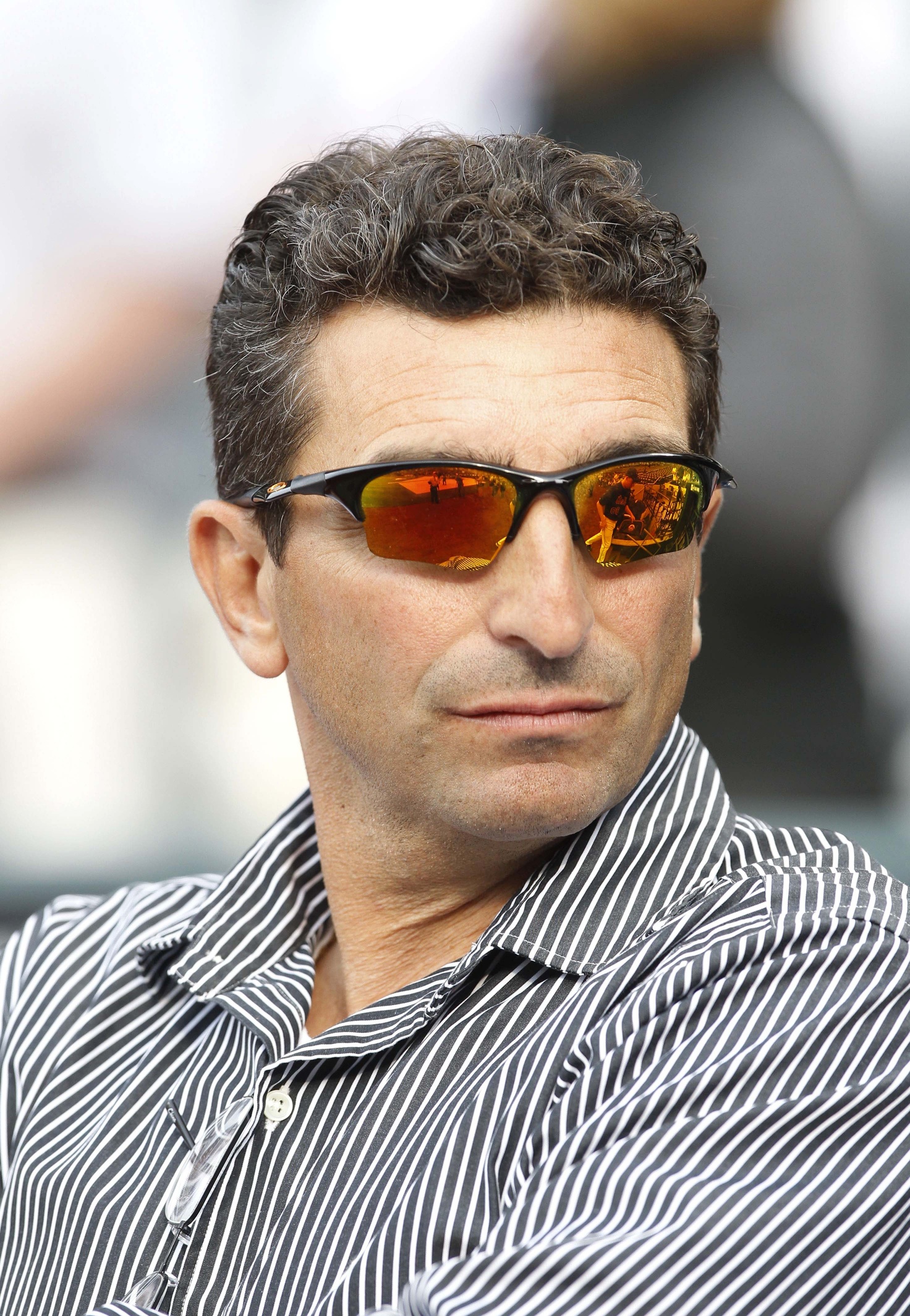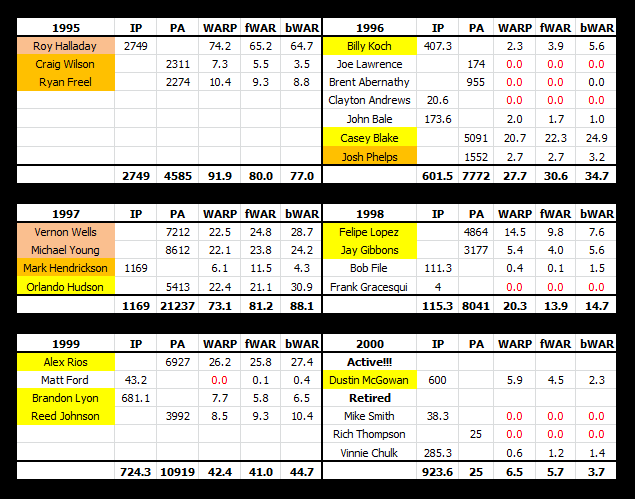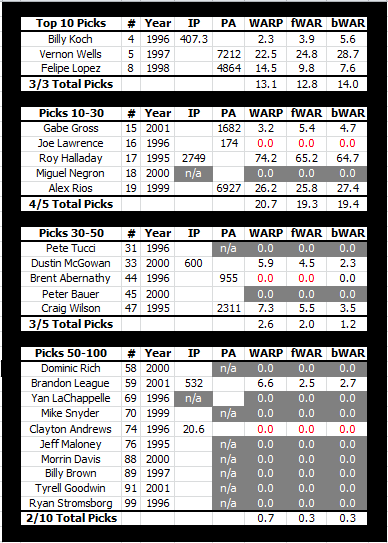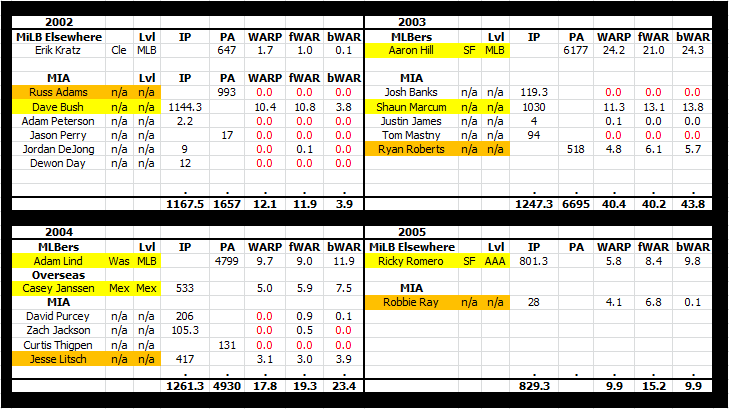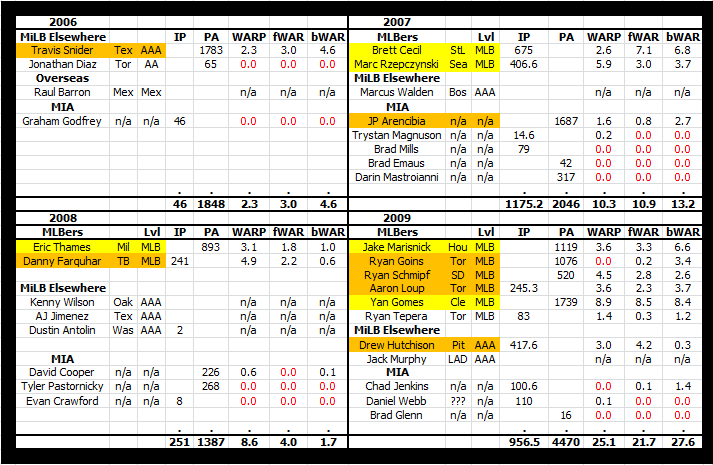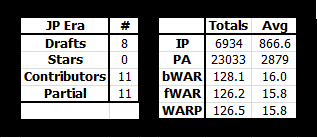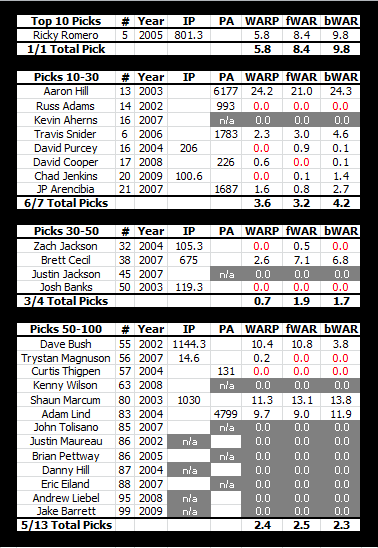What is the value a major league team can expect a draft class to produce?
This is the question that had been bouncing around my head for the past few weeks, since an offhand Twitter discussion between myself, Joshua Howsam (BP Toronto Co-Editor-in-Chief), and Jesse Goldberg-Strassler (Lansing Lugnuts broadcaster) got my brain spinning on the topic. In order to attempt to answer this question, I went all the way back to the 1995 draft (the start of the Gord Ash era) to get a large enough sample size. While only looking at one of the thirty major league teams isn’t sufficient to make determinations about the average Major League draft class, it will at least give us an idea of what the Jays generally produce.
Before we dive into the results, I think it’s appropriate to define some terms and also to look at exactly what teams are looking for when they are selecting players in the June draft. I see there as being four objectives that clubs are looking to achieve in the draft.
1 – Hunt for stars
2 – Find core players
3 – Find major league contributors
4 – Fill out major league depth with fringe big leaguers
===================
Given that criteria, I’ve divided players into 4 categories.
Stars – Marked in Pink
Contributors – Marked in Yellow
Partial Contributors – Marked in Orange
Major Leaguers, but not Contributors – Unmarked
These classifications were made incredibly unscientifically – and if people would like to quibble with how I’ve classified any players I’d encourage you to do so in the comments – but I had to make the cut off somewhere. Any player that didn’t make the major leagues is unaccounted for by my method. As far as I see it, unless a player is able to at least reach the major leagues, they have provided no value to their club.
With that said, there are two criteria that I used when evaluated drafted players. First, how much major league playing time did they receive (gauged in Innings Pitched or Plate Appearances). Secondly, I looked at how good they were (gauged by the suite of WAR metrics).
Also of note, any player who produced negative WAR is scored at zero (and denoted in red). It doesn’t seem logical to punish a team for a player for making the major leagues only to achieve poorly, when had he been even worse and not made the majors in the first place, they’d have been scored a zero.
Finally, I’m aware that the General Manager has minimal input on the draft process (and essentially none once you get past the first couple rounds), and most of the credit/blame for achievements in the draft should go to their scouting departments. However, it’s handy to use the change of the top executive as a way to break time into epochs and switches in overall draft philosophy.
Gord Ash
The first thing that jumped out to me when looking at Gord Ash’s draft history is that, holy crap, Dustin McGowan is still active! Who on earth would’ve figured that the last active player from this crop would’ve been the guy who’s had his shoulder cut on twice, to go along with knee & elbow surgeries. We really don’t spend enough time marveling at all the work Dustin must’ve put into his career.
Ash’s 1997 draft deserves a special highlight as I believe it’s the best Blue Jays draft in modern history. Coming away from a draft with three 20+ WAR hitters, all of whom I think could be argued were stars (though I don’t give the O-Dog that designation) is the gold standard that anyone can expect from a single class. It’s worth keeping this class in mind when we’re tracking Alex Anthopoulos’ 2010 draft class, since this is as good as things get.
While I don’t have a terrific baseline to compare against, I think it’s worth noting that Ash had a good amount of success in the later rounds (which I’m classifying as outside the top 100 picks). Aside from the three late pick successes in the aforementioned 1997 draft, adding a borderline star in the criminally underrated Casey Blake as well as a cadre of role players like Jay Gibbons, Reed Johnson, & Brandon Lyon is more than you could typically expect.
The 2000 draft stands out as an especially notable miss for Ash and the rest of his team. In that year, the Jays were equipped with 5 top 100 picks, and came away with only the injury marred career of Dustin McGowan to show for it.
The other way I looked at each GM was to compare how they handled each tier of picks.
While Ash did a very good job with his various first round picks (with only two failing to turn into at least major league contributors) he essentially struck out entirely when picking in the 2nd and 3rd rounds.
It’s also worth noting that it’s a bad thing when you fail to pick between 20 and 30 for your entire tenure (a problem that’s continued into the next administration as well). Being a Blue Jays fan was pretty darn rough for this 15 year span.
My bottom line takeaway from looking at the drafting tenure of Gord Ash (an era that I only vaguely remember personally), is that he was quite good at this. I’m not sure if I expanded my sample to include other clubs if that belief would hold up. I also fear J.P. Ricciardi’s lack of success may be tainting my thoughts here.
J.P. Ricciardi
What can I say; this is just a bloodbath.
J.P. Ricciardi appears to have been an exceptionally poor drafter, almost regardless of how you choose to evaluate the process. He failed completely at landing a star, he universally underachieved with his first round picks, and his late round selections failed to make up the difference.
While I would normally be reluctant to offer final thoughts about a GM’s draft history less than eight years after his termination, it’s really shocking just how few players that the J.P. Ricciardi-led Blue Jays drafted are still relevant major league contributors. Aside from his final draft in 2009 (which we’ll get to later), J.P.’s legacy is down to the pair of Adam Lind and Aaron Hill (whose careers are winding down), the returning Eric Thames, and a pair of left handed relievers in Marc Rzcepczynski and Brett Cecil. That’s it!
The barren wasteland that is the 2005 and 2006 drafts seems especially galling. The only big leaguers those drafts produced were Ricky Romero (Ricciardi’s highest draft pick) and Travis Snider (JP’s highest rated prospect), who both massively underachieved. Aside from that, both drafts were complete shutouts. Part of the issue with both of the years is that the team lacked draft capital: The Blue Jays were without a second round pick in both 2005 and 2006, and in 2006 they were also lacking a third round pick. While this does explain some of the poor results, it doesn’t explain away completely missing on literally every other pick in the draft.
On the flipside, the 2009 draft jumps off the page when looking at Mr. Ricciardi’s tenure, and not just because it’s by far his most successful. While the draft started out incredibly poorly with another first round miss in Chad Jenkins and the failure to sign Canadian second round pick James Paxton (who would’ve been the best player J.P. ever drafted) it was followed by a steady stream of big leaguers. It’s when looking at this draft class that the flaws of Ricciardi’s conservative, college-heavy approach come into the sharpest relief, since it seems this draft was run under a much different ethos. It stands out that the two most notable success stories from this draft come from the lottery ticket type of draft approach I would personally advocate for. I’m not sure that Ricciardi would’ve pulled the trigger on a raw high upside outfielder like Jake Marisnick or a relatively unknown Brazilian catcher like Yan Gomes had he not been on the hotseat, but they wound up being his best draft picks.
While the stark difference between outcomes between first round picks and the rest of the top 100 picks stood out when looking at Gord Ash history, it’s the exact inverse that is shocking when it comes to Mr. Ricciardi. Only having one of your nine first round picks emerge as a major league contributor is a shockingly low number.
As a bit of a diversion, when looking at JP Ricciardi’s draft history, I can’t help but think of Moneyball and the ideas espoused in that seminal work in regards to draft strategy. The biggest issue I’ve always had with the book was Michael Lewis lionizing Billy Beane’s strategy of focusing on college players who were perceived as safe, but had a relatively low upside. Even at the time I was reading a book that’s shaped my life more than any other published work, it struck me as odd that a strategy that hadn’t borne any results yet was receiving so much praise. If the career arc of one Jeremy Brown wasn’t enough to dissuade you that Mr. Beane’s strategy was flawed, looking at the work done by his prodigy Mr. Ricciardi should solidify that thinking.
Now that Ash and Ricciardi are done, all that remains it so look at the work of Alex Anthopoulos. That will come in a separate piece soon.
Lead Photo © The Star-Ledger-USA TODAY Sports
